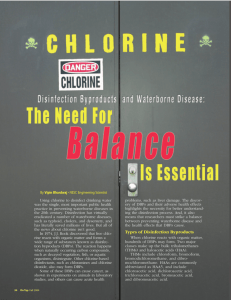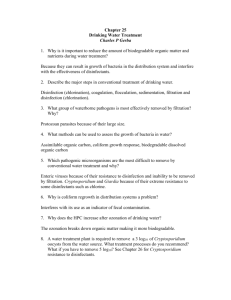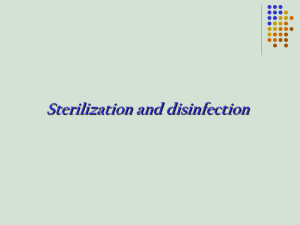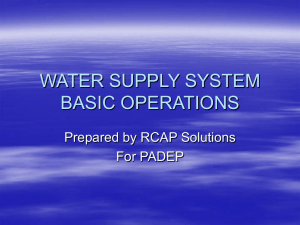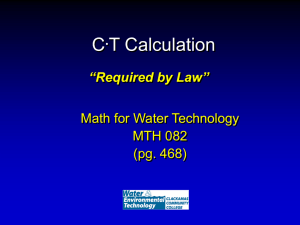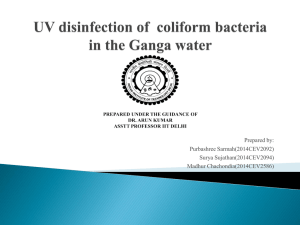Specific Disinfection By-Product - Florida Section of the American
advertisement
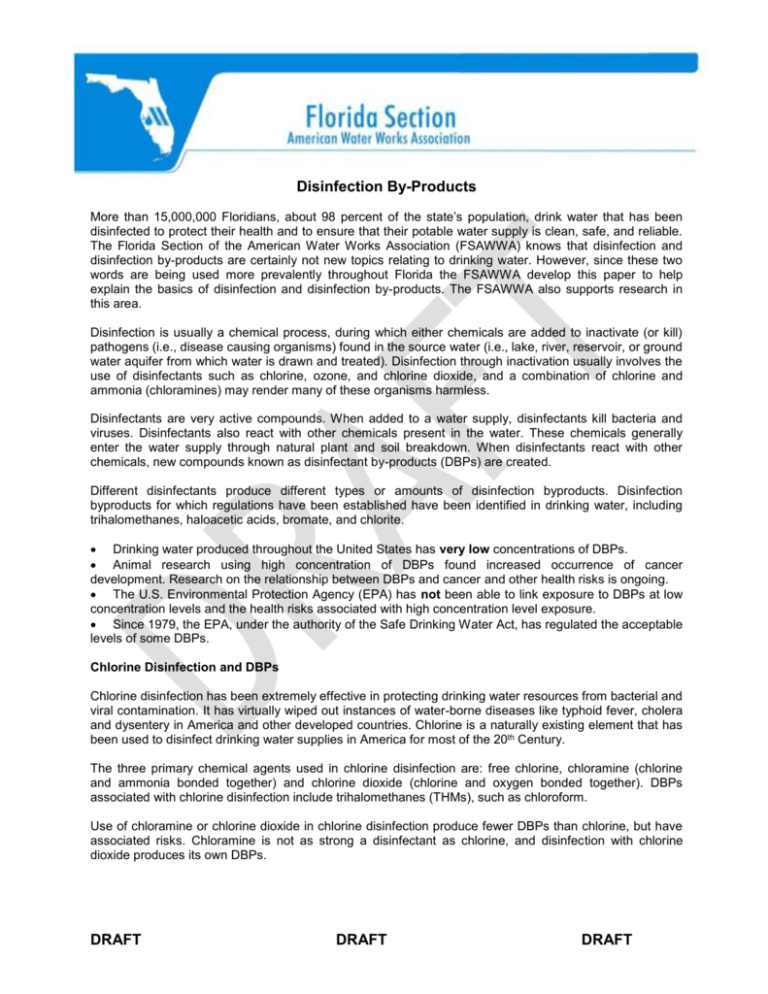
Disinfection By-Products More than 15,000,000 Floridians, about 98 percent of the state’s population, drink water that has been disinfected to protect their health and to ensure that their potable water supply is clean, safe, and reliable. The Florida Section of the American Water Works Association (FSAWWA) knows that disinfection and disinfection by-products are certainly not new topics relating to drinking water. However, since these two words are being used more prevalently throughout Florida the FSAWWA develop this paper to help explain the basics of disinfection and disinfection by-products. The FSAWWA also supports research in this area. Disinfection is usually a chemical process, during which either chemicals are added to inactivate (or kill) pathogens (i.e., disease causing organisms) found in the source water (i.e., lake, river, reservoir, or ground water aquifer from which water is drawn and treated). Disinfection through inactivation usually involves the use of disinfectants such as chlorine, ozone, and chlorine dioxide, and a combination of chlorine and ammonia (chloramines) may render many of these organisms harmless. Disinfectants are very active compounds. When added to a water supply, disinfectants kill bacteria and viruses. Disinfectants also react with other chemicals present in the water. These chemicals generally enter the water supply through natural plant and soil breakdown. When disinfectants react with other chemicals, new compounds known as disinfectant by-products (DBPs) are created. Different disinfectants produce different types or amounts of disinfection byproducts. Disinfection byproducts for which regulations have been established have been identified in drinking water, including trihalomethanes, haloacetic acids, bromate, and chlorite. Drinking water produced throughout the United States has very low concentrations of DBPs. Animal research using high concentration of DBPs found increased occurrence of cancer development. Research on the relationship between DBPs and cancer and other health risks is ongoing. The U.S. Environmental Protection Agency (EPA) has not been able to link exposure to DBPs at low concentration levels and the health risks associated with high concentration level exposure. Since 1979, the EPA, under the authority of the Safe Drinking Water Act, has regulated the acceptable levels of some DBPs. Chlorine Disinfection and DBPs Chlorine disinfection has been extremely effective in protecting drinking water resources from bacterial and viral contamination. It has virtually wiped out instances of water-borne diseases like typhoid fever, cholera and dysentery in America and other developed countries. Chlorine is a naturally existing element that has been used to disinfect drinking water supplies in America for most of the 20th Century. The three primary chemical agents used in chlorine disinfection are: free chlorine, chloramine (chlorine and ammonia bonded together) and chlorine dioxide (chlorine and oxygen bonded together). DBPs associated with chlorine disinfection include trihalomethanes (THMs), such as chloroform. Use of chloramine or chlorine dioxide in chlorine disinfection produce fewer DBPs than chlorine, but have associated risks. Chloramine is not as strong a disinfectant as chlorine, and disinfection with chlorine dioxide produces its own DBPs. DRAFT DRAFT DRAFT Since 1984, American drinking water utilities have spent almost $23 million researching the production of DBPs, the risks posed by them and methods to treat them. These research efforts are ongoing. In addition, the 300 largest drinking water utilities have spent more than $150 million to conduct the information gathering required by the Information Collection Rule (ICR). The ICR is the largest study to date pertaining to the occurrence of DBPs and associated treatment practices. The Safe Drinking Water Act Amendments of 1996 required EPA to comply with the regulatory timeline it set forth in its Interim Enhanced Surface Water Treatment Rule (IESWTR) and initial Disinfectant and Disinfectant-By-Product (DDPB) rule. Both rules were proposed in 1994. DDBP Rule Stage 1 Stage 1 of the DDBP rule establishes the following course of action: Establishes a goal of completely removing four particular THMs from American water supplies. Reduced the acceptable level of total THMs by 20 percent. Introduced a new group of DBPs, haloacetic acids (HAA5), for regulation. Requires water suppliers to reduce levels of total organic carbon, which reacts with disinfectants to make DBPs. Requires the levels of disinfectants in water after disinfection to be reduced. DDBP Rule Stage 2 Stage 2 of the DDBP rule, scheduled for implementation after July 2004, establishes the following course of action: Establishes requirements for community water systems to evaluate distribution systems to identify locations with high DBP concentrations. Identified locations will be used as monitoring sites for DBP compliance monitoring. Requires compliance for THMs and haloacetic acids are calculated for each monitoring location. Previous requirements determined compliance by calculating the running annual average of samples from all monitoring locations within a system. Specific Disinfection By-Product Trihalomethanes (THMs) are a group of four chemicals that are formed along with other disinfection byproducts when chlorine or other disinfectants used to control microbial contaminants in drinking water react with naturally occurring organic and inorganic matter in water. The trihalomethanes are chloroform, bromodichloromethane, dibromochloromethane, and bromoform. EPA has published the Stage 1 Disinfectants/Disinfection Byproducts Rule to regulate total trihalomethanes (TTHM) at a maximum allowable annual average level of 80 parts per billion. This standard will replace the current standard of a maximum allowable annual average level of 100 parts per billion in December 2001 for large surface water public water systems. The standard became effective for the first time in December 2003 for small surface water and all ground water systems. Haloacetic Acids (HAA5) are a group of chemicals that are formed along with other disinfection byproducts when chlorine or other disinfectants used to control microbial contaminants in drinking water react with naturally occurring organic and inorganic matter in water. The regulated haloacetic acids, known as HAA5, are: monochloroacetic acid, dichloroacetic acid, trichloroacetic acid, monobromoacetic acid, and dibromoacetic acid. EPA has published the Stage 1 Disinfectants/Disinfection Byproducts Rule to regulate HAA5 at 60 parts per billion annual average. This standard became effective for large surface water public water systems in December 2001 and for small surface water and all ground water public water systems in December 2003. Bromate is a chemical that is formed when ozone used to disinfect drinking water reacts with naturally occurring bromide found in source water. EPA has established the Stage 1 Disinfectants/Disinfection Byproducts Rule to regulate bromate at annual average of 10 parts per billion in drinking water. This standard will become effective for large public water systems by December 2001 and for small surface water and all ground public water systems in December 2003. 2 Chlorite is a byproduct formed when chlorine dioxide is used to disinfect water. EPA has published the Stage 1 Disinfectants/Disinfection Byproducts Rule to regulate chlorite at a monthly average level of 1 part per million in drinking water. This standard will become effective for large surface water public water systems in December 2001 and for small surface water and all ground water public water systems in December 2003. Disinfection Byproduct Health Effects Since the discovery of chlorinating byproducts in drinking water in 1974, numerous toxicological studies (studies on the health effects from exposure to high dosages contaminants usually involving animals in a lab) have been conducted. These studies have shown several disinfection byproducts to be carcinogenic in laboratory animals (e.g., including bromate, certain trihalomethanes and haloacetic acids). Some disinfection byproducts have also been shown to cause adverse reproductive or developmental effects in laboratory animals (e.g., chlorite and certain trihalomethanes and haloacetic acids). However, there is considerable uncertainty involved the results of high-dose, toxicological studies of some byproducts occurring in disinfected drinking water to estimate the risk to humans from chronic exposure to low doses of these and other byproducts. In the area of epidemiology (studies of the factors that influence disease in human populations), a number of studies have been completed investigating the relationship between exposure to chlorinated surface water and cancer. Some have suggested an increased cancer risk to those exposed to chlorinated waters while others have demonstrated none. In issuing the Stage 1 Disinfectants/Disinfection Byproducts Rule based on evidence then available, EPA stated that while the agency cannot conclude there is a causal link between exposure to chlorinated surface water and cancer, these studies have suggested an association, albeit small, between bladder, rectal, and colon cancer and exposure to chlorinated surface water. There are fewer epidemiology studies evaluating the association between exposure to disinfection byproducts and reproductive and developmental effects. Again, some have suggested an increased risk from exposure to disinfection byproducts while others have shown none. There remains considerable debate in the scientific community on the significance of these contradictory findings concerning chlorinated water and disinfection byproducts. As with cancer, EPA stated in its Stage 1 Disinfectants/Disinfection Byproducts Rule that, based on data then available, the agency can not conclude there is a causal link between exposure to disinfection byproducts and reproductive and developmental effects. In sum, EPA believes the weight-of-evidence presented by the available epidemiological studies on chlorinated drinking water and toxicological studies on individual disinfection byproducts support a potential hazard concern and warrant regulatory action at this time such as that taken in the Stage 1 Disinfectants/Disinfection Byproducts Rule. An extensive research effort (1997 Update to ORD's Strategic Plan, National Toxicology Program) is currently underway to better understand the potential risks attending exposure to disinfection byproducts. While this research is being completed, an agreement among water suppliers, environmental groups, consumer groups, and regulatory agencies has been reached, resulting in the publication of a Stage 1 Disinfectants/Disinfection Byproducts Rule by EPA in the Federal Register in December 1998. The participants recommended that while additional information, especially on health effects, is needed, the Stage 1 Disinfectants/Disinfection Byproducts Rule was considered the best course of action to reduce potential risks from disinfection byproducts in the near term. Note: It is recommended that contact information, Web site address and FSAWWA mission statement is added to each issue paper.) 3

